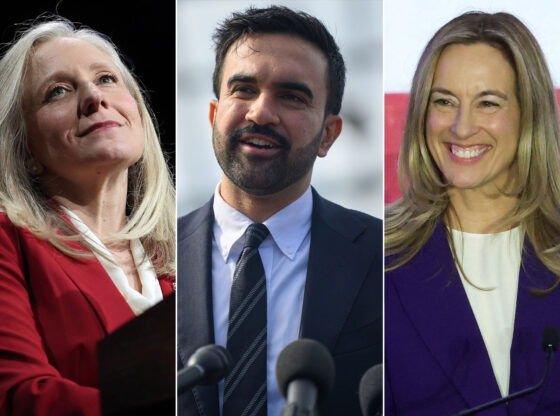Published On 8/11/2025
|
Last update: 14:47 (Mecca time)
An interview conducted by the New York Times between prominent political analysts, Frank Bruni, Sarah Anderson, and Nate Silver, reviewed the features of the American political scene after the recent elections in New York City and the states of New Jersey and Virginia, with a special focus on the status of President Donald Trump within the Republican Party.
The dialogue also touched on the ongoing debate between the progressive movement, led by new figures, such as the new mayor of New York, and the centrist movement, represented by figures, such as Abigail Spanberger and Mickey Sherrill, who won the governorships of Virginia and New Jersey in the recent US gubernatorial elections.
Read also
list of 2 itemsend of list
The discussion begins with a sarcastic comment from Bruni about some Republican politicians trying to imitate Trump in his populist behavior, such as appearing in fast food restaurants to appeal to ordinary voters.
Trump is not imitated
Sarah Anderson argues that these attempts do not work because “Trump is not imitated,” as he has a unique ability to appeal to the cultural and political instincts of working-class white voters.
However, Anderson pointed out that the essence of his success lies not in populist display as much as in the promise he offers to voters that they will be able to live safely and affordably, which should be the focus of any politician seeking to win their trust.
Bruni then goes on to talk about the election results in New York, where Mamdani won the position of mayor of the city, becoming the first Muslim and the youngest person to hold this position in more than a century.
Bruni raises a question about the model that the Democratic Party should adopt at the federal level: Is it the progressive model represented by Mamdani, or the centrist model embodied by moderate figures such as Spanberger and Sherrill?
Nate Silver: Mamdani was able to overcome broad prejudices in a politically and ethnically diverse city, even though parts of it leaned toward Trump in the 2024 elections.
Charismatic populism
Anderson responds that Republicans are mocking Mamdani’s rise and expect that adopting his approach will lead to the decline of Democrats, but she warns against underestimating him, as he possesses remarkable rhetorical ability, and is proficient in what she calls “charismatic populism” that combines charisma and direct communication with people.
She believes that voters, especially those whom Trump tried to win over, have become more willing to ignore extremist political positions if they feel that the candidate is capable of achieving tangible results.
Nate Silver adds that he admires Mamdani’s political skills, as he was able to overcome broad prejudices in a politically and ethnically diverse city, even though parts of it leaned toward Trump in the 2024 elections.
Silver points out that opinion polls have shown that many Americans are still hesitant to elect Muslim candidates, which makes Mamdani’s victory a notable achievement. But he also points out that former Governor Andrew Cuomo’s campaign was very weak and helped Mamdani’s rise.
Silver believes that the empirical data clearly indicates that centrist candidates generally achieve better electoral results, as long as conditions are equal.
The opposite of Kamala Harris
He adds that the presence of a progressive wing within the party is not necessarily a negative thing, provided that it is represented by smart and young faces like Mamdani, who is able to interact with public opinion and amend his previous positions frankly, unlike what former presidential candidate Kamala Harris did, who had difficulty convincing voters of the sincerity of her political transformations.
As for Bruni, he believes that the Democrats will not fully adopt the Mamdani model, but they will realize the importance of the energy and vitality that he represents, and the need for candidates with charisma and a strong media presence, especially in a time governed by social media.
He warns that the Democratic Party, despite its recent successes, may come to wrong conclusions that lead to strategic errors, pointing to a series of disastrous decisions made by Democrats in recent years due to misreading the electoral results.
The danger of overconfidence
Silver agrees with him that there is a danger of excessive confidence, as happened after the 2022 midterm elections when the Democrats achieved better results than expected, so they believed that the performance of former President Joe Biden was sufficient to continue for a second term, which stopped the discussion of renewing leadership.
He asserts that he prefers a competitive primary within the party because Democratic voters, contrary to popular impression, act relatively rationally and think about “electability” as much as they think about ideological issues.
Anderson believes that the Democratic base, despite its tendency to the left compared to the centrist voter, is still more disciplined than the Republican base, which allowed the rise of extremist candidates during the so-called “Tea Party” era, which lost many electoral opportunities.
The two parties are facing a difficult test
She adds that the most participating voters in the Democratic Party primaries are the same ones who supported Joe Biden in 2020, meaning that they are still inclined toward pragmatism and not toward ideological extremism.
The dialogue concludes that the two American parties face a difficult test: Republicans are looking for an alternative that matches Trump in his popular influence without repeating his political chaos, while Democrats are trying to balance the appeal of new faces from the progressive wing with the requirements of electoral realism.
In light of this, it seems that American democracy is entering a phase of redefining its discourse and its leadership figures, at a time when the rules of political communication and social alignment are changing at an unprecedented speed.

